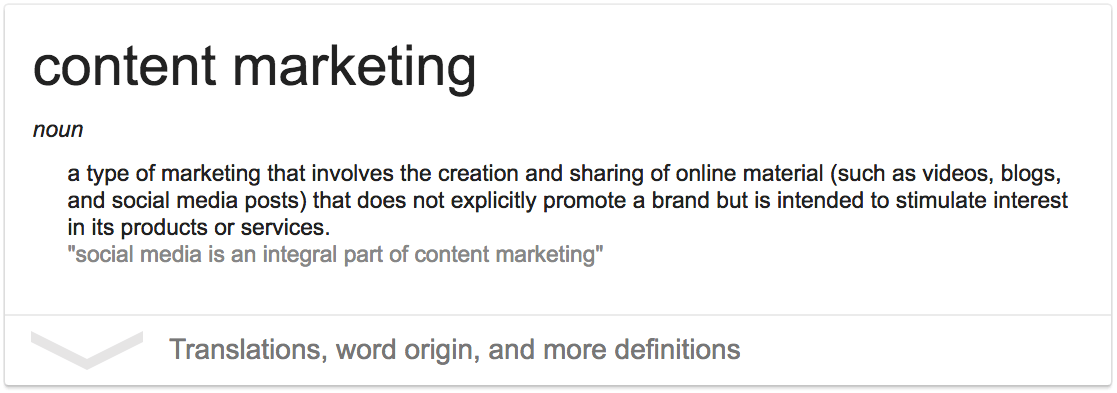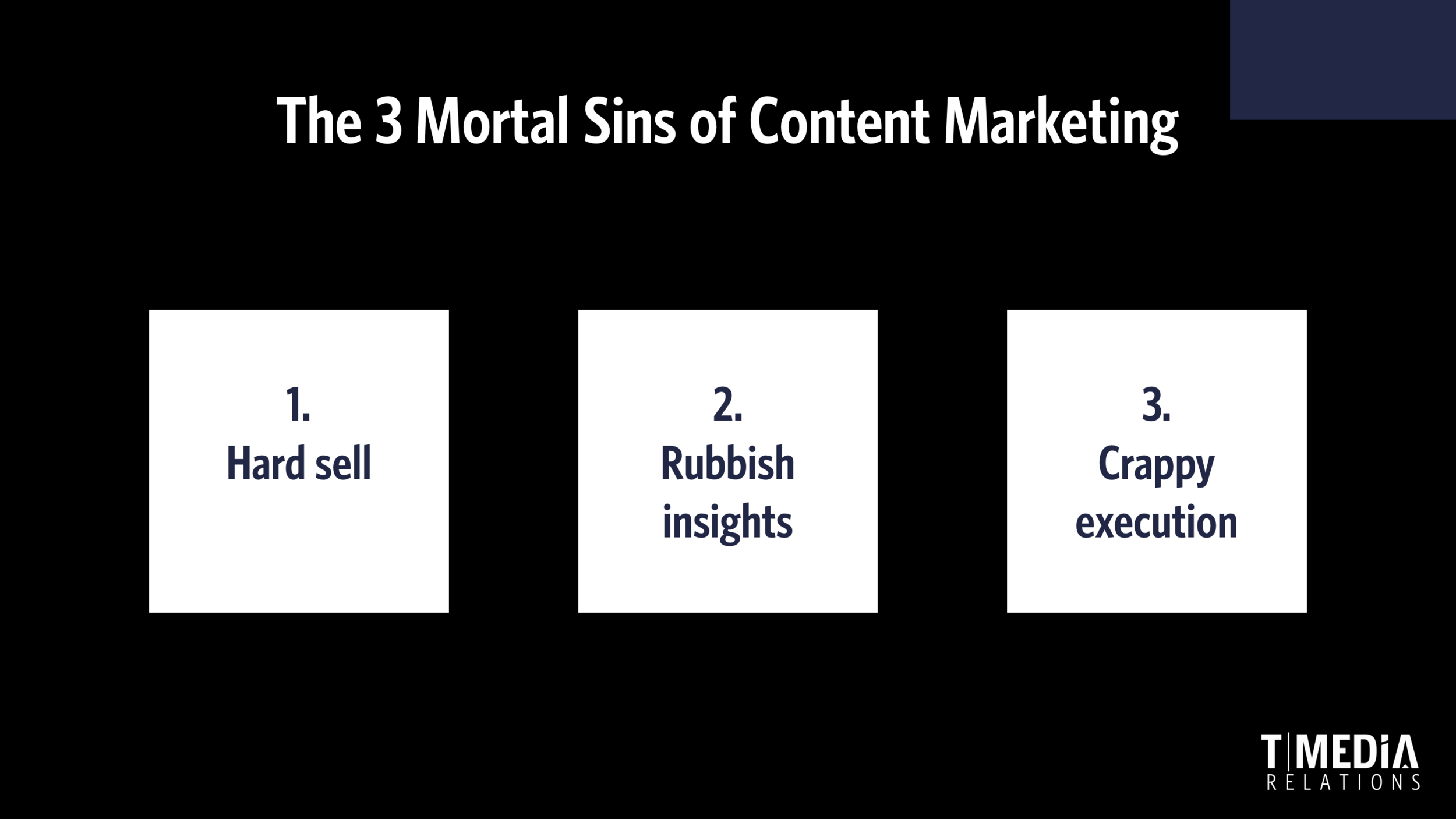The 3 Mortal Sins of Content MarketingSisältömarkkinoinnin kolme kuolemansyntiä
The world of communications and marketing has embraced the era of content marketing with open arms. Content marketing is perhaps most often understood, and if you believe Google’s definition, in Pic 1, as being online content that isn’t direct sell, but rather tries to lead the audience to view the brand in question favourably. In other words, not trying to force the proverbial horse to drink, but gently direct it towards the water.
Yet, many of us have had painful encounters with content designed for the purpose.

“Content, dressed as a blog post that doesn’t benefit me, won’t work,” said someone I recently talked to. “And hard sell just puts me off.”
Someone else I discussed with said, “One should have something to say. Forced blog posts aren’t at all convincing. I don’t need some crap that just takes up my time.”
That said, I think we are at a stage in the content marketing lifecycle, where advanced organisations already know what they’re doing with the art. A recent report by Content Marketing Institute shows that 62% of North American content marketers feel that their organisation’s content marketing success has been better than in the previous year. The two top reasons for the development were seen to be:
- Higher quality and more effective production of content (named by 85% of respondents)
- The development or adjustment of content strategy (72% of respondents).
Why then is an encounter with content marketing so often such an unpleasant experience? Pic 2 lays out the mortal sins of content marketing. They are hard sell (“We opened a new petrol station you CAN’T LIVE WITHOUT!”), rubbish insights (“In buying IT services, it is important to have an IT strategy.”) and crappy execution (“Our exprets have great expertise, book your time slot for a call with our phone help now!”).

The underlying cause for bad content marketing, which manifests itself in the three mortal sins, is that its focus isn’t in actually trying to help the customer – whose eventual question in any commercial engagement will be, what’s in it for me? Changing one’s attitude to content marketing is the first step in getting better at it.
This first step should lead to the elimination of the three mortal sins.
There’s a lot more to the topic. I will be returning with more tips in later posts. Stay tuned.
Meanwhile, if you have questions, or just want to chat, please drop me a line, or give me a call. And thanks if you got this far!
![]()
Jirimiko Oranen
CEO, T-Media Relations
jirimiko.oranen@t-media.fi
+358 40 756 6655
Viestinnän ja markkinoinnin maailma on herännyt niin kutsutun sisältömarkkinoinnin iloihin. Sisältömarkkinoinnilla tarkoitetaan usein, ja jos Googlen määritelmää on uskominen, erityisesti verkkosisältöjä, jotka eivät suoranaisesti ole promoavinaan tiettyä brändiä, vaan pikemminkin pyrkivät herättämään kiinnostusta tuotteisiin tai palveluihin.
Useilla meistä on tuskallisia kokemuksia sisältömarkkinoinnin kohtaamisesta.

”Sisältö joka on muka blogimuotoista myyntitekstiä, mutta ei tuota minulle hyötyä, ei toimi”, sanoi hiljattain aiheesta haastattelemani henkilö. ”Pakkomyynti ottaa päähän.”
Toinen jolta asiasta kysyin, oli vielä suorapuheisempi:
”Pitää olla sanottavaa. Pakotetut blogit eivät vakuuta. Ei mitään paskaa joka vain vie aikaani.”
Olemme todennäköisesti siinä vaiheessa sisältömarkkinoinnin elinkaarta, jossa taitavimmat organisaatiot alkavat jo hallita taiteenlajin. Amerikkalaisen Content Marketing Instituten tuore tutkimus kertoo, että 62 % amerikkalaisista B2B-sisältömarkkinoijista piti oman organisaationsa sisältömarkkinointia onnistuneempana kuin edellisenä vuonna. Tärkeimpinä syinä parempaan onnistumiseen vastaajat pitivät laadukkaampaa ja tehokkaammin tuotettua sisältöä (85 %) ja sisältöstrategian laatimista tai kehittämistä (72 %).
Hyvin usein sisältömarkkinointi on edelleen kuitenkin vastenmielinen kokemus. Helmasyntien kärkeä ovat tyrkkymyynti (”avasimme uuden superkivan bensa-aseman, jota ilman et voi elää!”), olemattomat näkemykset (”it-palvelujen ostamisessa it-strategia on tosi tärkeä!” ja ala-arvoinen toteutus (”meidän firmassa on asian tuntijoita, varaa aikasi puhelin neuvojallemme nyt!”).

Näiden ilmentymien alla piilevä taudinaiheuttaja on se, että sisältömarkkinointi unohtaa asiakkaan, jonka kysymys aina lopulta on what’s in it for me?’ Ensimmäinen askel, joka auttaa eliminoimaan kuolemansynnit, on muuttaa markkinoijan oma asenne tekemiseensä.
Sisätömarkkinointi on laaja aihe, ja lisää vinkkejä on tulossa. Pysy taajuudella.
Jos aihe herättää kysymyksiä, ota yhteyttä!
![]()
Jirimiko Oranen
Toimitusjohtaja, T-Media Relations
jirimiko.oranen@t-media.fi
+358 40 756 6655





